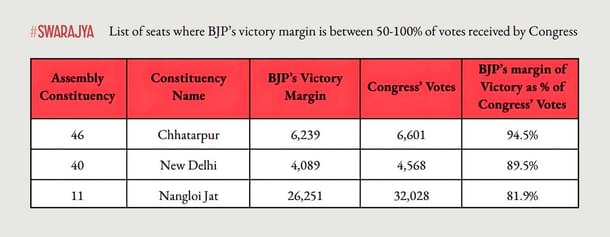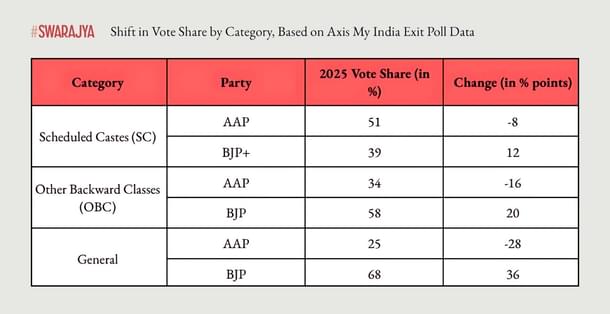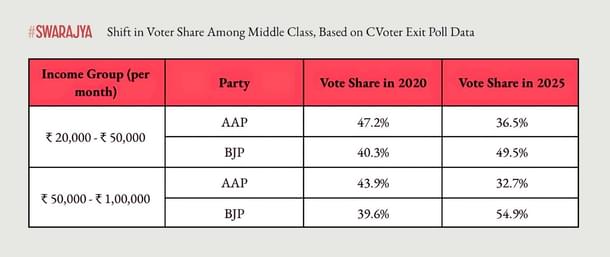Politics
Decoding Delhi Verdict: 8 Myths And Realities
Aditya Chauhan
Feb 22, 2025, 09:43 AM | Updated 09:43 AM IST
Save & read from anywhere!
Bookmark stories for easy access on any device or the Swarajya app.
The 2025 Delhi Assembly election will be remembered not merely as a political contest, but as a masterclass in strategic campaigning.
Against the backdrop of a fiercely entrenched opponent in AAP and a resurgent Congress, the BJP defied expectations to secure a decisive mandate, expanding its footprint across the capital with a seven percentage point surge in vote share and a commanding majority of 48 out of 70 seats.
Critics and opponents have framed BJP’s success as a byproduct of opposition disunity or support among SCs and Muslims. Yet, the numbers tell a different story.
This article dismantles eight such pervasive myths and unearths the real factors which have shaped the outcomes of Delhi Assembly Elections.
Myth: AAP lost primarily due to Vote-Splitting with Congress
Reality: While the Congress did eat into the opposition vote in some seats, the BJP’s win was often decisive. In 34 constituencies, the BJP’s margin of victory was larger than the entire vote share of the Congress.
Yes, there were 14 constituencies where Congress votes surpassed the BJP’s victory margin. But assuming every Congress vote would have gone to AAP is misleading.
In any case, some fraction of those votes would likely have migrated to the BJP. In 3 out of these 14 constituencies, the BJP's margin of victory was between 80-100% of the Congress' votes.
Even if only a portion of voters who voted for Congress shifted to BJP in its absence, the BJP would have won 37 seats comfortably—enough to form the Government in Delhi.

Myth: AAP Lost Support Among SCs and Muslims
Reality: AAP retained 8 of 12 SC-reserved seats and 6 of 7 Muslim-majority constituencies (losing only Mustafabad due to a three-way split with AIMIM and Congress).
The real shift occurred among General and OBC voters, who swung significantly towards BJP. While BJP made some inroads among SC voters, it was AAP’s declining support among General and OBCs that ultimately proved more damaging.

Myth: AAP Still Retains Middle-Class Support
Reality: Delhi’s middle and upper-middle classes turned sharply toward the BJP, motivated by dissatisfaction over infrastructure, pollution, and BJP’s tax rebates for incomes up to ₹12 lakh. BJP’s gains were most striking in Delhi’s middle-class heartlands—West, East, South, and New Delhi.
This election conclusively killed the idea of the "Kejriwal-Modi voter"—where voters backed Arvind Kejriwal in state elections and Narendra Modi in national polls.

Myth: Parvesh Verma Won Only Because of Sandeep Dikshit
Reality: In the New Delhi constituency, BJP’s Parvesh Verma defeated Chief Minister Arvind Kejriwal by 4,089 votes, while Congress’s Sandeep Dikshit tallied 4,568 votes.
However, Kejriwal’s vote count plummeted from 46,758 in 2020 to 25,999 in 2025. The drop in AAP’s votes shows a diminishing appeal of Kejriwal rather than a mere vote split.
Myth: Freebies Alone Can Win You Elections
Reality: BJP countered AAP’s freebie politics with a mix of welfare and governance. The party promised ₹2,500 monthly aid to poor women (higher than AAP’s ₹2,100), subsidized LPG, ₹5 meals for the poor, and free healthcare under Ayushman Bharat. Voters opted for BJP’s governance over AAP’s “freebies without governance” approach.
Myth: You Need a Local Face to Take on a Regional Party CM
Reality: BJP disproved the belief that defeating Kejriwal required a local CM face. Instead, the election was framed as a referendum on Modi’s governance versus AAP’s alleged mismanagement. Delhi’s verdict shows that in the Modi era, national leadership often trumps local identity.
Myth: 2024 Lok Sabha Elections Were the End of BJP-Modi Wave
Reality: After the 2024 Lok Sabha elections, critics declared the end of the Modi wave. But BJP’s continued state election victories—in Haryana, Maharashtra, and now Delhi—prove otherwise. The party remains the dominant political force.
Myth: Kejriwal Is Modi’s National Alternative
Reality: Kejriwal was once considered a potential challenger to Modi. However, AAP’s loss in Delhi exposed the frailty of that argument. While Modi successfully used the "Gujarat model" to rise to national power, Kejriwal failed to maintain his MLA seat based on the "Delhi model".
AAP’s governance missteps and corruption allegations have significantly weakened its credibility.
The Big Picture: Why This Election Matters
The 2025 Delhi elections weren’t just about 70 seats; they were a referendum on India’s political trajectory. BJP’s victory underscores its ability to combine welfare with governance while exposing AAP’s shortcomings.
For AAP, this election was a wake-up call: media narratives and freebies alone cannot sustain political dominance. Congress, once a formidable force in Delhi, has been relegated to irrelevance.
As the dust settles, the lessons from Delhi’s verdict will resonate far beyond the capital.
Aditya Chauhan works as a Policy Consultant. He tweets at @sirfaditya (www.x.com/sirfaditya)





